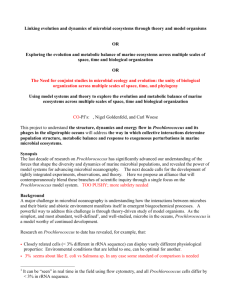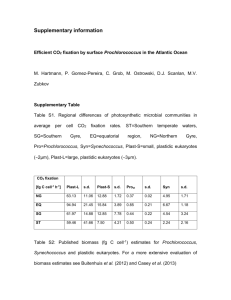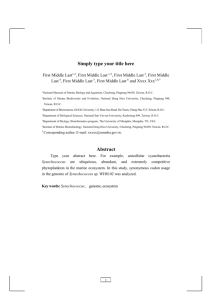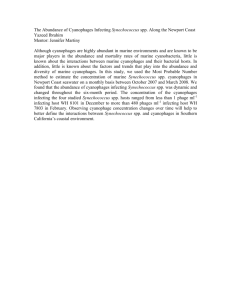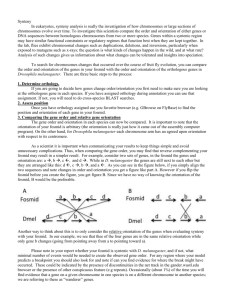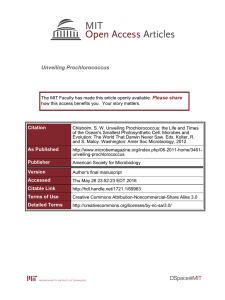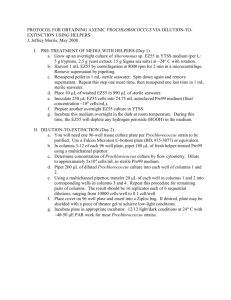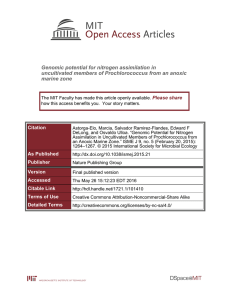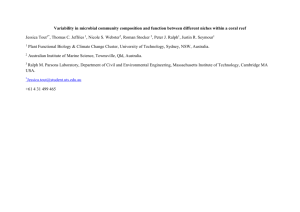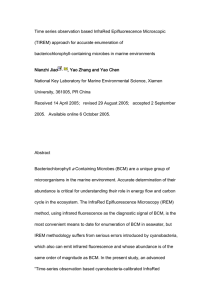טקס חלוקת מלגות ע"ש אורן ברקו ז"ל 2006
advertisement
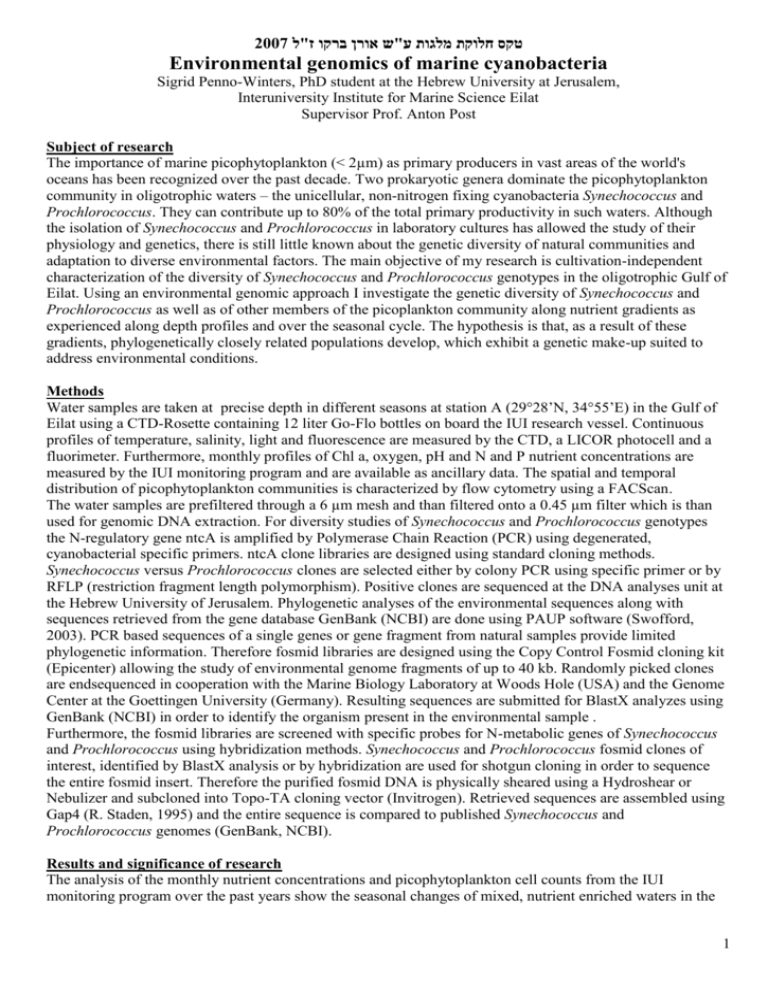
2007 טקס חלוקת מלגות ע"ש אורן ברקו ז"ל Environmental genomics of marine cyanobacteria Sigrid Penno-Winters, PhD student at the Hebrew University at Jerusalem, Interuniversity Institute for Marine Science Eilat Supervisor Prof. Anton Post Subject of research The importance of marine picophytoplankton (< 2µm) as primary producers in vast areas of the world's oceans has been recognized over the past decade. Two prokaryotic genera dominate the picophytoplankton community in oligotrophic waters – the unicellular, non-nitrogen fixing cyanobacteria Synechococcus and Prochlorococcus. They can contribute up to 80% of the total primary productivity in such waters. Although the isolation of Synechococcus and Prochlorococcus in laboratory cultures has allowed the study of their physiology and genetics, there is still little known about the genetic diversity of natural communities and adaptation to diverse environmental factors. The main objective of my research is cultivation-independent characterization of the diversity of Synechococcus and Prochlorococcus genotypes in the oligotrophic Gulf of Eilat. Using an environmental genomic approach I investigate the genetic diversity of Synechococcus and Prochlorococcus as well as of other members of the picoplankton community along nutrient gradients as experienced along depth profiles and over the seasonal cycle. The hypothesis is that, as a result of these gradients, phylogenetically closely related populations develop, which exhibit a genetic make-up suited to address environmental conditions. Methods Water samples are taken at precise depth in different seasons at station A (29°28’N, 34°55’E) in the Gulf of Eilat using a CTD-Rosette containing 12 liter Go-Flo bottles on board the IUI research vessel. Continuous profiles of temperature, salinity, light and fluorescence are measured by the CTD, a LICOR photocell and a fluorimeter. Furthermore, monthly profiles of Chl a, oxygen, pH and N and P nutrient concentrations are measured by the IUI monitoring program and are available as ancillary data. The spatial and temporal distribution of picophytoplankton communities is characterized by flow cytometry using a FACScan. The water samples are prefiltered through a 6 µm mesh and than filtered onto a 0.45 µm filter which is than used for genomic DNA extraction. For diversity studies of Synechococcus and Prochlorococcus genotypes the N-regulatory gene ntcA is amplified by Polymerase Chain Reaction (PCR) using degenerated, cyanobacterial specific primers. ntcA clone libraries are designed using standard cloning methods. Synechococcus versus Prochlorococcus clones are selected either by colony PCR using specific primer or by RFLP (restriction fragment length polymorphism). Positive clones are sequenced at the DNA analyses unit at the Hebrew University of Jerusalem. Phylogenetic analyses of the environmental sequences along with sequences retrieved from the gene database GenBank (NCBI) are done using PAUP software (Swofford, 2003). PCR based sequences of a single genes or gene fragment from natural samples provide limited phylogenetic information. Therefore fosmid libraries are designed using the Copy Control Fosmid cloning kit (Epicenter) allowing the study of environmental genome fragments of up to 40 kb. Randomly picked clones are endsequenced in cooperation with the Marine Biology Laboratory at Woods Hole (USA) and the Genome Center at the Goettingen University (Germany). Resulting sequences are submitted for BlastX analyzes using GenBank (NCBI) in order to identify the organism present in the environmental sample . Furthermore, the fosmid libraries are screened with specific probes for N-metabolic genes of Synechococcus and Prochlorococcus using hybridization methods. Synechococcus and Prochlorococcus fosmid clones of interest, identified by BlastX analysis or by hybridization are used for shotgun cloning in order to sequence the entire fosmid insert. Therefore the purified fosmid DNA is physically sheared using a Hydroshear or Nebulizer and subcloned into Topo-TA cloning vector (Invitrogen). Retrieved sequences are assembled using Gap4 (R. Staden, 1995) and the entire sequence is compared to published Synechococcus and Prochlorococcus genomes (GenBank, NCBI). Results and significance of research The analysis of the monthly nutrient concentrations and picophytoplankton cell counts from the IUI monitoring program over the past years show the seasonal changes of mixed, nutrient enriched waters in the 1 winter with eukaryotic algae abundance, the Synechococcus bloom at the onset of the stratification in spring and the dominance of Prochlorococcus in oligotrophic waters in the summer. The diversity of Synechococcus and Prochlorococcus populations in different seasons and depth with diverse nitrogen sources and availabilities was studied using the ntcA gene. This gene, unique to cyanobacteria and present as a single copy in the genomes plays a central role in nitrogen metabolism regulation in the cells. It proved to be an excellent diversity marker giving a much higher resolution in phylogenetic analyses than compared to standard diversity markers such as the 16S rRNA gene. An unexpected large diversity of distinct Synechococcus types including 4 new genotypes, but a rather uniform Prochlorococcus population exhibiting one genotype was found in the surface waters of the Gulf of Eilat. A multi-annual survey identified certain Synechococcus genotypes as generalists being present year around. Other genotypes showed seasonal alteration being more abundant and therefore better adapted to either the nutrient enriched environment in the winter/spring or to the nutrient poor (oligotrophic) waters in the summer. Contrary, one Prochlororoccus genotypes was identified throughout the year. Additional ntcA diversity studies in the Mediterranean Sea and the Arabic Sea showed the dominance of a different Prochlororoccus genotype in surface waters. Concluding, the existence and the seasonal or local alteration of different Synechococcus and Prochlorococcus genotypes can be linked to the nutrient status of the environment they inhabit and therefore support the theory of coexisting ecotypes well adapted to certain microhabitats. The results of these studies led to two publications (Journal of Limnology and Oceanography and Journal of Environmental Microbiology) and a third publication currently in preparation. Environmental, high molecular weight genomic DNA from two different seasons and depths, characterized by different nutrient and light availabilities were successfully cloned into fosmid vectors. Blast search analysis of so far over thousand fosmid clone endsequences provide for the first time an overview of organism within the size range of 0.45 to 6 µm present in the Gulf of Eilat. The majority of organisms belong to the eubacteria phylum (54%) and much less to the phyla of eukaryotes (5%), archaea (4%) and viruses (2%). 35% of the retrieved sequences could not be identified by the Blast search or are of unknown origin. Most of the eubacteria belong to the order of proteobacteria (53%) with all families (α, ß, γ, δ, ε) present, though to a different extent. Other orders of eubacteria were identified as planktomycetes (11%), actinomycetes (5%), flavobacteria (5%), cyanobacteria (5%), chloroflexales (4%) and others. Formerly described cyanobacteria species like Trichodesmium, Synechococcus and Prochlorococcus are present as well as others like Nodularia, Lyngbya, Cyanothece and Nostoc which so far have been never described in the Gulf . Only recent studies showed the occurrence of archaea in open oceans which is confirmed in this study with the majority belonging to the order of euryarcheota (88% of total archaea). Marine viruses are smaller than 0.2 µm and are known to be very abundant. They are underrepresented in our analysis due to the selected size fraction. Nevertheless viruses were detected, mainly bacteriophages and cyanophage. In the near future additional endsequences of two surface water fosmid libraries, one from a mixed and one from a stratified water column will complete the database of present picoplankton groups in the Gulf of Eilat. Through comparative analysis of fully sequenced genomes of Synechococcus and Prochlorococcus strains we were able to identify gene clusters essential for the uptake of different nitrogen sources like ammonium, urea, nitrite, nitrate and cyanate. The different strains showed great variation in presence or absence of these genes/ gene clusters. Synechococcus and Prochlorococcus environmental fosmid clones containing some of the above mentioned genes/ gene clusters were identified and fully sequenced. The comparison of environmental genome fragments to known genomes revealed the presence of specific genotypes with the genetic potential to utilize certain N sources. Some fosmid clones which derived from a water sample of 140 m in a stratified water column were identified as so called low light (LL) adapted Prochlorococcus with some genotypes been described previously in the Gulf but others are identified for the first time. Within our ntcA clone libraries from depth until 200 m LL Prochlorococcus were never detected. For more detailed information some of the LL Prochlorococcus fosmid clones are currently fully sequenced . Overall my research addresses the hypothesis that diversity in cyanobacterial genotypes (biodiversity) is matched by plasticity in the gene pool that mediates environmental stress responses (niche adaptation). The study will have an impact to better understand the importance, success and genetic potential of picophytoplankton species in oligotrophic waters where they contribute significant to primary production. It will provide better in sight in the environmental conditions that affect diversity, succession and productivity of the marine phytoplankton. 2
